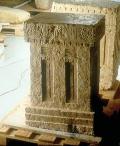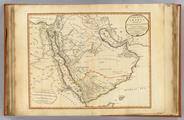Archaeological Findings
|
|
|
Kinderhook Plates
|
|
1843
|
|
(A set of 6 brass plates discovered in 1843 in an Indian mound near Kinderhook, Illinois. According to Joseph Smith "they contain the history of the person with whom they were found and he was a descendant of Ham through the loins of Pharaoh king of Egypt") |
|
|
|
(Note:
In 1879 Wilbur Fugate claimed to have forged these plates with the help of Bridge Whitten and Robert Wiley. Today they are universally accepted as a hoax.)
|
|
|
|
|
|
|
Newark Holy Stones
|
|
1860
|
|
(Three objects discovered by David Wyrick near Newark, Ohio in 1860, inscribed in Hebrew, including a condensed version of the Decalogue, or Ten Commandments.) |
|
|
|
(Note:
Due to the unprofessional manner in which these stones were discovered they have not been dated. However, the letters themselves indicate that they most likely come from a Hebrew language between 100 AD and 300 AD. General consensus believes they are either a hoax or originate from a post-Colombian time period. These stones were discussed by Orson Pratt in the December 1 issue of the Millenial Star.)
|
|
|
|
|
|
|
Bat Creek Stone
|
|
1889
|
|
(Inscribed stone discovered in Native American burial mound in Loudon County, Tennessee, 1889) |
|
|
|
(Note:
In 1970 it was proposed that the letters on this stone were Paleo-Hebrew, including a reference to Judea, suggesting an ancient connection with the Old World, but mainstream scholarship has declared this stone a fraud.)
|
|
|
|
|
|
|
Michigan Relics
|
|
1890
|
|
(A series of nearly 3,000 artifacts allegedly discovered in Michigan in 1890 by James Scotford, bearing evidence of ancient Near Eastern culture) |
|
|
|
(Note:
These artifacts have been repeatedly declared to be forgeries. In 1909 Mormon scientist James E. Talmage investigated the objects and came to the same conclusion. Nevertheless, up until 2003 the LDS church kept 797 specimens in the Salt Lake City Museum.)
|
|
|
|
|
|
|
Tucson Artifacts
|
|
1924
|
|
(A series of 31 artifacts, shaped like crosses, swords, and javelins, discovered by Charles E. Manier near Picture Rocks, Arizona, in 1924. These objects contain both Hebrew and Latin engravings, including Latin inscriptions of Roman numerals of years from 790 to 900 AD) |
|
|
|
(Note:
Because the inscriptions are nearly identical to excerpts from Classical authors, such as Cicero, Virgil, and Horace, all writings which were available in Tucson at the time, and due to linguistic irregularities, these artifacts are commonly considered a hoax.)
|
|
|
|
|
|
|
Bar Kokhba Coins
|
|
1932-67
|
|
(A series of three coins, one discovered in Louisville in 1932, one near Clay City in 1952, and one in Hopkinsville in 1967, all in Kentucky. They resemble coinage minted by the Jews during the Bar Kochba revolt against the Roman Empire of 132-135 AD) |
|
|
|
(Note:
These coins have been identified as forgeries/replicas, made near the beginning of the 20th century for sale to tourists to the Holy Land.)
|
|
|
|
|
|
|
Los Lunas Decalogue Stone
|
|
1933
|
|
(Contains an abridged version of the Decalogue, or Ten Commandments, near Los Lunas, New Mexico) |
|
|
|
(Note:
In 1985 Geologist George Moorhouse compared these inscriptions to that on a nearby modern graffito and roughly estimated their age at 500 to 2000 years. However, due to site contamination the age has never been scientifically verified, and the authenticity of this stone is in question due to charges against its discoverer, Frank Hibben, for having fabricated archaeological evidence to support his pre-Clovis migration theory in two other cases.)
|
|
|
|
|
|
|
Khirbet Beit Lei
|
|
1961
|
|
(Ancient burial complex discovered near Hebron, Israel, including a cave with carved drawings and inscriptions, dated 6th century BCE) |
|
|
|
(Note:
It has been proposed that the prophet Lehi once resided at this site in Israel, and that some of the inscriptions depict part of Lehi's journey to the Americas, but both Mormon and non-Mormon scholars have declared that claim unlikely. More information here.)
|
|
|
|
|
|
|
Brewer's Caves
|
|
1963-75
|
|
(A collection of 12 limestone tablets and 7 lead plates, discovered in two caves by John Brewer in Manti, Utah, between 1963 and 1975. The engravings on these items have yet to be deciphered) |
|
|
|
(Note:
The existence of the caves has never been confirmed, and the objects produced have often been called frauds, including by professors at Brigham Young University.)
|
|
|
|
|
|
|
Burrows Cave
|
|
1982
|
|
(Alleged cave in Southern Illinois discovered by Russell Burrows, containing vast treasures and artifacts) |
|
|
|
(Note:
The existence of this cave has never been confirmed. It has been suggested based on the artifacts sold by Burrows that the treasure contained in the cave was the lost treasure of King Solomon, and was brought to America by the Mulekites, but today there is universal agreement that the objects produced by Burrows are forgeries and that the cave is a hoax.)
|
|
|
|

|
|
External Link
|
|
Journal of Book of Mormon Studies 10/2 (2001): pgs 59-61
|
|
|
|
|
NHM Altar 2
|
|
1988
|
(English Translation)
Bi'athar son of Sawdum, son of Naw'um, of the tribe of Nihm, has dedicated to Ilmaqah the person Fari'at. By 'Athtar, and by Ilmaqah, and by Dhat-Himyam, and by Yada'-il, and by Ma'adi-karib. |
|
|
|
(Note:
This altar, dated approximately 600 BCE, was found at the Bar'an temple in Marib, Yemen, which was excavated from 1988 to 1997, and opened to the public on November 18, 2000. The Arabic letters for "NHM" translated above as "Nihm" are traced in green in the photograph. One possible pronunciation of NHM is Nahom, the burial site of Ishmael in the Book of Mormon and location where the family of Lehi changed direction on their journey away from Jerusalem.)
|
|
|
|

|
|
External Link
|
|
Journal of Book of Mormon Studies 10/2 (2001): pgs 59-61
|
|
|
|
|
NHM Altar 1
|
|
1988
|
|
(inscription essentially the same as Altar 2) |
|
|
|
(Note:
This altar, dated approximately 600 BCE, was removed from its original location at the Bar'an temple in Marib, Yemen, and put on tour with the Queen of Sheba exhibit in Europe in October, 1997.)
|
|
|
|

|
|
External Link
|
|
Journal of Book of Mormon Studies 10/2 (2001): pgs 59-61
|
|
|
|
|
NHM Altar 3
|
|
1988
|
|
(inscription essentially the same as Altar 2) |
|
|
|
(Note:
This altar, dated approximately 600 BCE, pictured in the back row on the far right, was found in the excavation of the Bar'an temple in Marib, Yemen, and moved to the raised sanctuary of the temple.)
|
|
|
|

|
|
External Link
|
|
Arabia, by Jean Baptiste Bourguignon Anville, 1794, David Rumsey Historical Map Collection
|
|
|
|
|
1794 Map
|
|
12 May, 1794
|
|
(Old map showing the location of "Nehem") |
|
|
|
(Note:
Marib, the location of the discovery of the NHM altars above, is shown as "Mareb" on this map. It is also important to note that the character roughly transliterated as "h" in the place called Nehem is not the same as the corresponding character on the NHM altars.)
|
|
|
|
|